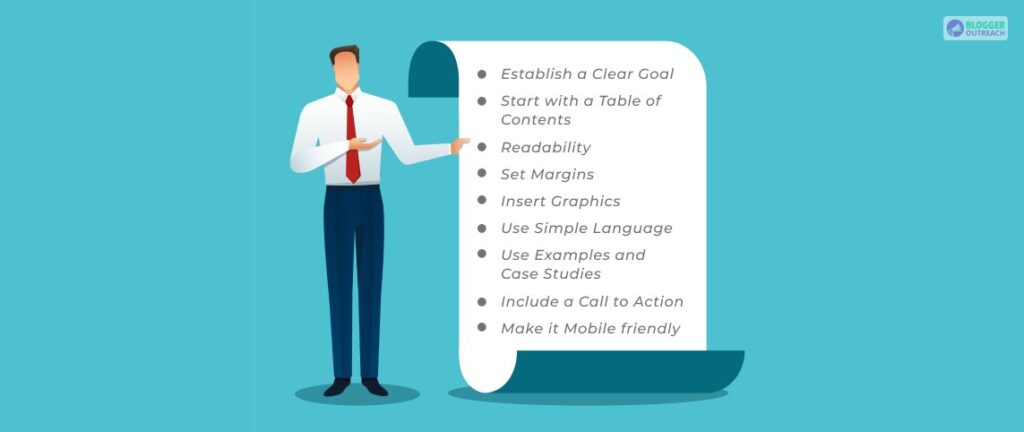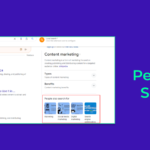Table Of Content
Are you looking for ways to strengthen your business’s authority and demonstrate thought leadership in your industry?
Writing a whitepaper is one of the best solutions!
It’s an opportunity to share your knowledge and expertise in an authoritative, engaging, and creative way.
Leveraging whitepapers helps you create something insightful, valuable, and persuasive to build trust with your target audience and establish yourself as a thought leader in your niche.
Writing an effective whitepaper requires a combination of-
- Research.
- Writing skills.
- Marketing prowess.
- Understand the formatting guidelines.
- Professional approach.
- Easy to read.
When done correctly, a whitepaper can be a powerful tool for driving leads and creating a strong brand image.
To help you get started, here are our best tips for writing and formatting a whitepaper that will help you stand out from the crowd.
What Are Whitepapers?

A whitepaper is an essential tool for making informed decisions. It’s an in-depth, authoritative report on a specific topic, providing-
- A detailed overview of the issue.
- Possible solutions.
- Guidance for readers.
- About a product or service.
- Provide evidence-based information that supports a company’s claims.
- Explain the complex concepts.
- Government can use it to explain a product or service they offer.
Whitepapers are often longer than traditional essays and may include charts, tables, and illustrations.
They are also typically well-researched and written in a formal, professional tone.
Writers of whitepapers must be able to present their ideas clearly and concisely and must have a good understanding of the topic they are writing about.
The introduction summarizes the topic and briefly summarizes the main points.
The author feeds an in-depth breakdown of the issue, including a discussion of the evidence backing their position through the body.
The conclusion typically summarizes the main points and provides a call to action.
Why Should You Use Whitepapers?

If you’re an entrepreneur, content marketer, or small business owner, whitepapers are an essential tool. Here are the top four benefits of whitepapers.
(i) Building Authority And Credibility
They provide authoritative information about a particular topic and can be used to inform and educate customers, partners, and potential investors.
By providing an in-depth look at a particular issue, whitepapers can be invaluable in helping to build brand credibility and trust.
(ii) Become A Thought Leader
Whitepapers are a great way to showcase your expertise and knowledge on a particular topic.
They can provide a comprehensive overview of a product or service, discuss the latest industry trends, and explain the value proposition of a particular solution. This helps to establish a business as a thought leader in its field and can help to build trust with customers and partners.
(iii) Promote Your Business
Whitepapers are immensely helpful in promoting products or services.
They can provide detailed information about a particular offering, including features, benefits, and pricing. This can establish a competitive edge and differentiate a business from its competitors.
Additionally, whitepapers aid you in generating leads and building relationships with potential customers.
(iv) Enhances Visibility
Finally, you can capitalize on whitepapers to increase visibility and attract investors. They can provide an in-depth look at a business’s operations, financials, and growth potential. This can demonstrate a particular business’s value and attract potential investors.
Overall, whitepapers are an invaluable tool for businesses of all sizes. Whitepapers enable you to demonstrate expertise, promote products, and attract potential customers and investors.
Click Here To Read Out: Drawbacks Of Pay Per Click Marketing
How To Write A Whitepaper?

It is essentially a research paper that includes comprehensive research, analysis, and recommendations on a specific topic or problem.
Step 1 – Select A Topic
The first step in writing a whitepaper is to select a topic. First, choose a topic that is relevant to your organization or industry.
Here Are A Few Tips For Choosing A Topic:
- Consider current trends, customer needs, and potential solutions to your problem.
- You want to pick something relevant and interesting to your audience.
- Don’t fake your knowledge; write something that you have enough knowledge and resources to explain.
When Deciding On A Topic, Ask Yourself These 3 Questions:
- What aspects of my industry do I want to bring to light?
- Can I analyze and share a specific angle or feat that my team accomplished?
- Is there any important information that is missing from the conversation?
Choose a topic that you have a deep understanding of and that will be engaging for your readers. Your whitepaper should be an expert document, so ensure you have the facts to support your findings.
Step 2 – Determine Your Audience
Before you begin writing your whitepaper, it’s important to determine who you’re writing it for.
Depending on your audience determine the tone and style of your paper. Ensure that the information you’re providing is accurate and meets the expectations of your audience.
Ask The Following Question To Understand Your Audience Accurately:
- What piques the interest of my audience in this topic?
- How does my audience typically obtain information?
- What is the current level of knowledge about this topic among my audience?
- What further insights into this subject does my audience seek?
- How will my whitepaper be beneficial for them?
- What kind of research and analysis should I include that is most applicable to my audience?
Once you have a clear head about your audience, you’re good to go!
Step 3: Conduct Research
Once you have selected a topic, research to gather the necessary information.
Use A Variety Of Sources, Including:
- Books.
- Articles.
- Videos and other online resources.
- Consider going through other whitepapers, reports, etc.
- Also, consider conducting interviews and surveys to gain insights from industry experts and customers.
Fact-Checking:
Verifying the credibility and relatability of your resources is a must! The smartest way of doing this is by providing the same information from multiple sources.
Analyze The Data:
After gathering the necessary information, analyze it to create an argument. Then, consider the evidence, arguments, and counter-arguments to develop a well-researched and organized argument.
Step 4: Writing The Whitepaper
Once you have analyzed the data, it is time to write the whitepaper.
Structuring The Outline:
This will help you determine how long your paper should be, what topics you should cover, and how to organize the information.
Include an introduction, body, and conclusion. Use clear and concise language to explain the argument and provide evidence to support it.
This will give you a roadmap to follow when writing and help you stay organized.
Create An Irresistible Title:
Before doing anything, you need to grab your readers’ attention, and the title or headline should take center stage.
To craft an attention-grabbing title for your whitepaper that will draw readers in, BloggerOureach recommends these helpful tips:
- Entice your readers
- Make promises
- Be clear and concise
- Be creative
- Include a subtitle
Introduction:
Start your paper with an introduction that clearly states your main points and gives readers an idea of what to expect.
Heading And Subheadings:
Incorporating proper subheadings throughout the content helps the readers to scan your content. Therefore, write Headings and subheadings in bold and use them consistently throughout the document.
Supporting Evidence:
After you’ve introduced your main points, provide evidence to support them. This could include facts, statistics, case studies, or other information that can support your claims.
Step 5: Edit And Proofread
A small mistake can outweigh all your efforts. So never neglect this part. Editing and proofreading involve checking whether everything is in place or not.
Try to look for the following:
- Typing errors.
- Grammatical mistakes.
- Wrong formatting.
- Not meeting the reader’s intent.
- Duplicate facts or sentences.
The Best Format For Whitepapers

Write your whitepapers in a specific format, with the major conclusion usually appearing at the end of the document.
(i) Abstract:
The abstract should provide a brief overview of the whitepaper’s main points and allow the readers to understand if the document is relevant to their needs.
(ii) Problem Statement:
The problem statement should clearly define the issue and provide context to help the readers understand it.
(iii) Introduction:
This section provides the necessary context for readers to understand the problem and solution.
It may include detailed and technical information, or broad and high-level content, based on the context of the problem and the audience.
(iv) Solution:
The ‘ta-da’ moment of whitepapers, this section presents the proposed solution, supported by evidence and the author’s and company’s expertise.
(v) Conclusion
This section summarizes the major findings of the whitepaper. Here most people provide recommendations based on the solutions.
(vi) References
All sources used to develop the whitepaper must be cited in this section. Properly citing sources adds validity to the document and gives the reader content for further research. Depending on the industry, follow MLA or APA citation formats.
Whitepaper Best Practices

At this point, you know the steps for writing whitepapers. Let’s add more value to your bucket. Here are the ways how your cloud makes your whitepaper more effective:
(i) Establish A Clear Goal:
Before starting to write your whitepaper, it is important to establish a clear goal. It would help if you cleared up the problem you’re trying to solve, who the target audience is, and what the main message of the whitepaper will be.
(ii) Start With A Table Of Contents:
To make it easier for readers to navigate your whitepaper, you should include a table of contents. This leads to easier and quicker information scanning for the readers.
(iii) Readability:
When selecting a font, it’s important to keep in mind readability and how it will appear on the page. Popular fonts for whitepapers include Arial, Times New Roman, Calibri, and Verdana.
(iv) Set Margins:
Setting the correct margins is essential for creating a professional-looking document. Margins should be wide enough for readers to easily read the text without feeling cramped.
(v) Insert Graphics:
Including visual elements in your whitepaper can help to illustrate your points and make the document more engaging. Graphics can include charts, diagrams, photos, and other visuals.
(vi) Use Simple Language:
Make sure to use simple language when writing your whitepaper. This will make it easier for readers to understand your points.
(vii) Use Examples And Case Studies:
Provide examples and case studies to illustrate your points. This will help your audience understand your message and see how your solution can be effective in real-world scenarios.
(viii) Include A Call To Action:
Incorporate a crystal clear call to action at the end of your whitepaper. This will prompt your audience to take action and get involved in your solution.
(ix) Make It Mobile Friendly:
With the increasing accessibility of mobile phones, now more people access whitepapers compared to what they used to be. So you should optimize your whitepaper for mobile.
Promoting Your Whitepaper

Congratulations! If you’ve made it to this point, you have all the ingredients you need to create amazing whitepapers that stand out from the crowd.
But remember, your whitepaper is only the beginning. In today’s business world, quality content is essential to connecting with your target market.
Check out the following information; you’ll be fully equipped to create whitepapers and all types of content that will attract and convert your desired audience.
(i) Optimize Your Whitepaper For SEO: SEO (Search Engine Optimization) is one of the most important ways to promote your whitepaper. Ensure you optimize your whitepaper with the right keywords, meta tags, and descriptions. You can use tools like Google’s Keyword Planner to find the right keywords to focus on.
(ii) Utilize Social Media: Social media is one of the best ways to promote your whitepaper. Create content around your whitepaper and share it on various social media platforms. You can also use platforms like Twitter, Facebook, LinkedIn, and other social media channels to reach out to potential readers.
(iii) Create A Landing Page: A landing page is an effective way to promote your whitepaper. Create a landing page that clearly outlines the benefits of your whitepaper. Include a call-to-action, such as a free download of your whitepaper, to encourage readers to take the next step.
(iv) Leverage PR Opportunities: You can also use PR opportunities to promote your whitepaper. Reach out to journalists and bloggers in your industry and ask them to cover your whitepaper.
(v) Email Marketing: Send an email to your existing contacts about your whitepaper and ask them to share it with their contacts. Please include a link to your landing page and encourage people to download it.
Time To Take Action!
Whitepapers are different from other business reports, often placing the main conclusion at the start.
The whitepaper format allows the content and research to gradually inform the reader and increase their knowledge of the problem before revealing the solution in the final section.
By leveraging, not only will you be able to solve a problem and educate your audience, but you will also collect leads that you can nurture into loyal customers. Ready to get started?
Thanks for reading our helpful guide on how to write a whitepaper. For more useful articles on content marketing, check out our blog.
Read Also:








